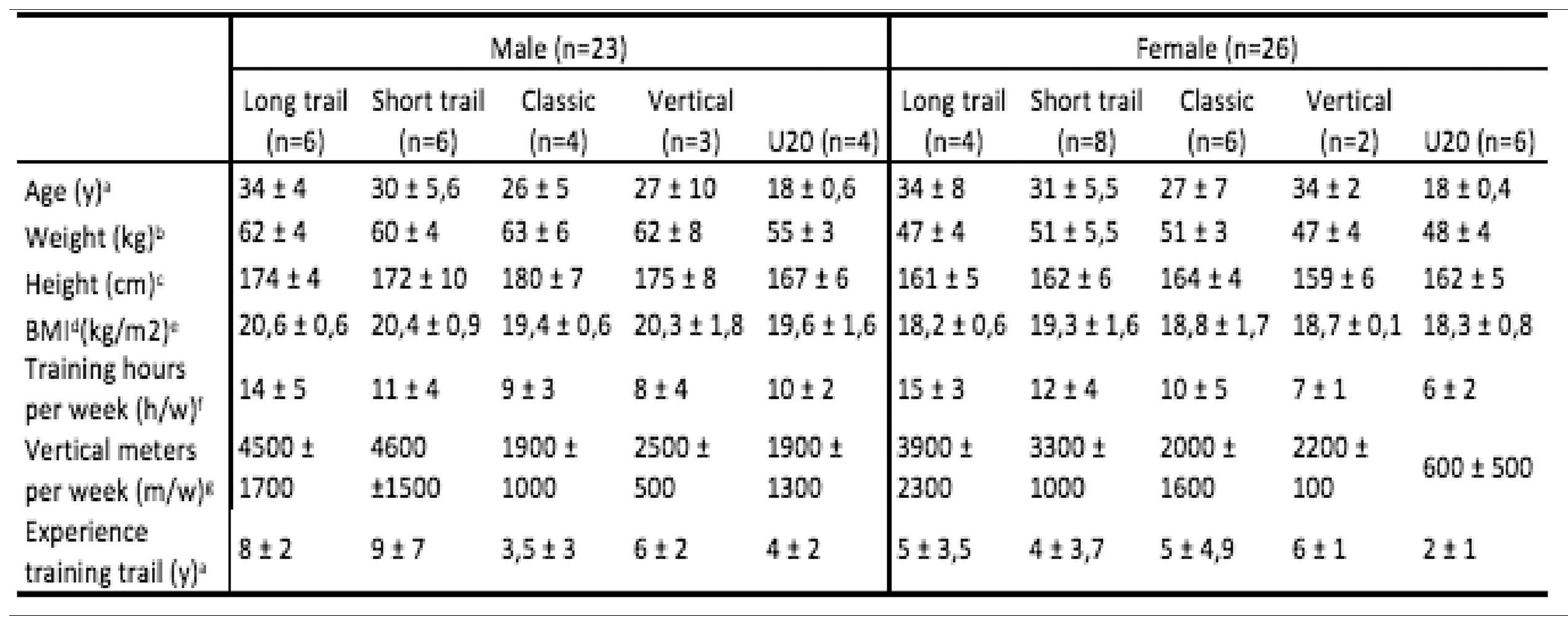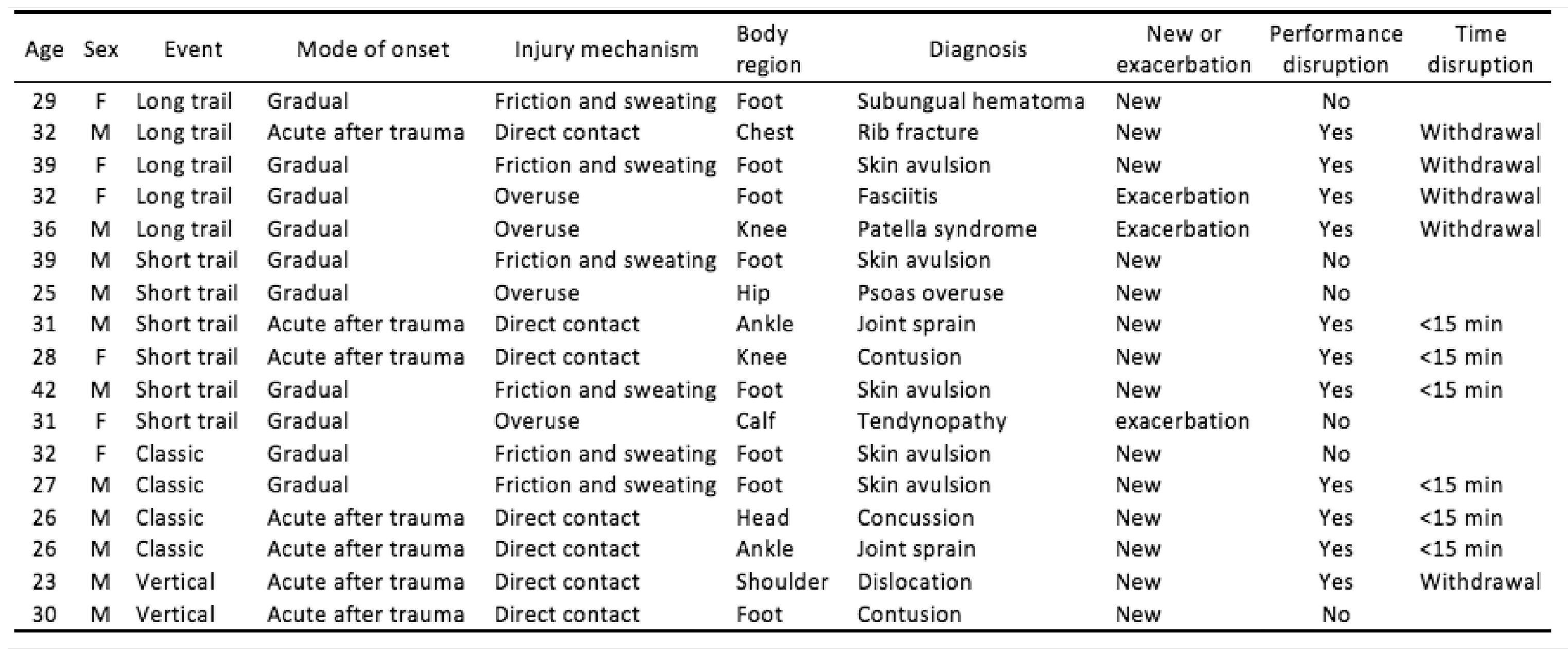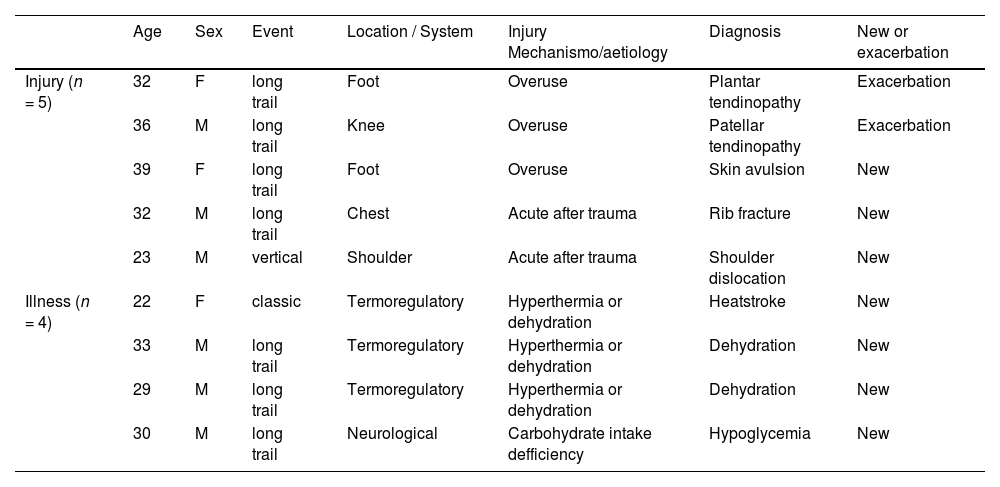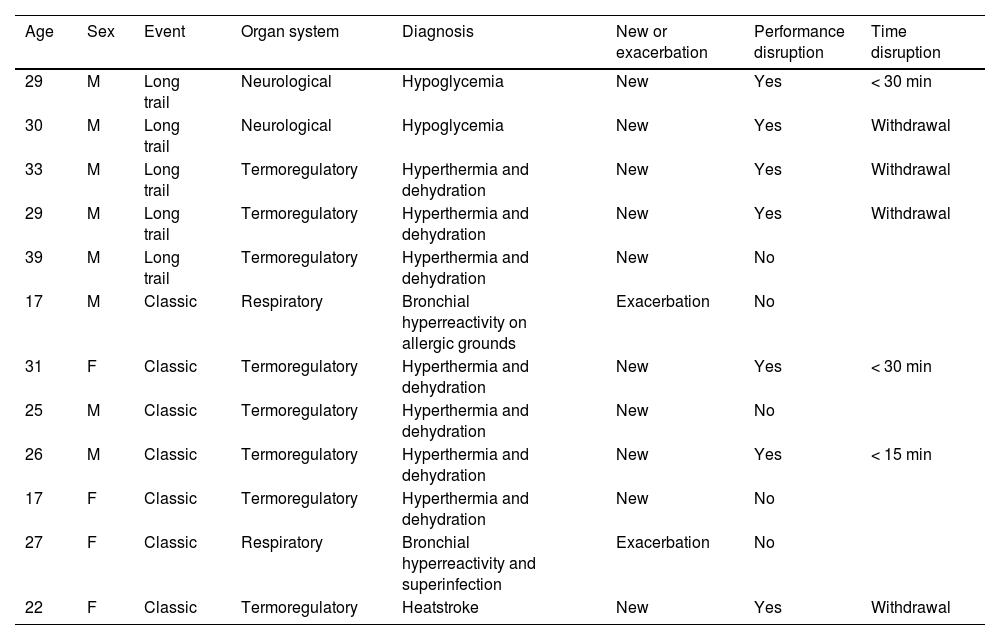As a result of the recent professionalization of trail running, the epidemiology of injury and illness of professional athletes is still unknown. The aim of the study is to describe the epidemiology of musculoskeletal injuries and illnesses among professional trail runners of two national teams participating at the World Mountain and Trail Running Championships 2023.
Material and MethodsThe study included 77 professional trail running athletes from Spanish and French National Teams that competed in the Championships. Data of injuries and illnesses were recorded in “Daily Medical Report on Injuries and Illnesses” form, designed according to the recommendations of the International Olympic Committee consensus statement.
ResultsThirty-eight percent of the athletes had an injury or illness; of them 22 % suffered an injury and 16 % an illness. Regarding sport performance, 24 % of the athletes suffered an injury and illness that affect their sport performance and 12 % had to withdraw due to a major injury or illness. By anatomical location foot is the most affected and hyperthermia and dehydration are the most frequent aetiology of illness.
ConclusionsMore than one third of professional trail running athletes suffered an injury or illness during the World Championship and around one in ten were unable to finish the competition due to a major injury or illness. The principal cause of withdrawal is dehydration, followed by overuse injuries and acute traumas.
Trail running is the most popular off-road (e.g. unsealed surface and natural environment) running event.1 By definition trail running is a foot race in a natural environment including mountains, deserts, forests, coastal areas, jungles/rainforests, grassy or arid plains over a variety of different terrains (e.g. dirt road, forest trail, single track, beach sand, etc.) with minimal paved or asphalt roads.1 Distances range from a few kilometres to more than 80 km and the average inclination should include a minimum of 5 % and not exceed 25 %.1,2
The International Trail Running Association (ITRA) defines trail running as a pedestrian race with a clearly marked route (usually in natural environments and terrains such as mountains, deserts, forests or plains) with a maximum of 20 % of the total route on paved road.3 Participants are semi to fully self-sufficient and are sometimes required to use running packs in races to carry limited nutritional supplies and safety equipment (e.g. clothing or communication).4
Trail running has become increasingly popular and participation has grown substantially in recent years, with an estimated 15 % annual growth rate.5 Only in the US, the number of participants has grown from 4,8 million in 2009 to 9,1 million in 2017.1
At the same time the number of participants has grown, trail running has undergone progressive professionalization as a result of the promotion of national and international federations and the support of important sports sponsors. In 2015, trail running was recognised by the World Athletics (WA) as a discipline of athletics5 and in November 2022 ITRA and WA organised jointly the first World Mountain and Trail Running Championships (WMTRC) in Thailand6; and in June 2023 the second WMTRC was held in Austria7 with more than 70 national teams and 1200 athletes.
Furthermore, trail running has a number of particular risks for the health of athletes that differentiate it from on road races or track and field competitions: uneven surfaces, distance covered, altitude, environmental conditions and endurance effort affected by large elevation gains/losses.8 Therefore, trail running presents a high risk of injury.9 The last systematic review10 reports an injury incidence range 0,7–61,2 injuries/1000 h of running and prevalence range 1,3 % to 90 %.
Due to its recent popularity,11 the number of epidemiological publications about injuries and illnesses in mountain runners is low,1 especially if we refer to professional runners. The current evidence comes mainly from cross-sectional studies obtained in single-day competitions which are focused on injuries and illnesses during competition and whose population is mainly male runners of middle age and amateur level.9,10
The aim of this paper is to describe the epidemiology of injuries and illnesses among professional trail runners during World Mountain and Trail Running Championships 2023.
Material and methodsStudy design and populationA descriptive, cross-sectional study was designed. The target population was Spanish and French international level athletes that were selected by, respectively, the Spanish and French Athletics Federations, to participate in the World Mountain Trail Running Championships held in Innsbruck (Austria) in June 2023.7 We choose these target population because Spanish and French teams were one of the few teams that presented athletes in all events, with similar distribution by categories and had team doctor available for collecting data.
The Spanish National Team was made up of 38 athletes (21 male and 17 female) and the French National Team of 39 athletes (20 male and 19 female). The athletes’ distribution by event was: 8 Spanish and 11 French athletes participated in long trail; 11 Spanish and 12 French in short trail; 7 Spanish and 4 French in mountain classic; 5 Spanish and 4 French in vertical and 7 Spanish and 8 French under-20 category.
The World Championships was made up of 5 events: long trail was 86 km race with 6500 metres of positive vertical elevation; short trail was 45 km race with more than 3100 metres of positive vertical elevation; mountain classic was 15 km race and 700 metres of positive vertical elevation; under-20 category was the same race as mountain classic but for under 20 years old athletes; and vertical was a 7 km race with 1000 metres of positive vertical elevation.7
Data collectionAll the athletes of both national teams were invited to complete a pre-participation questionnaire (PQ) that recorded data about the personal and training characteristics of the participants (i.e. age, sex, height, weight, body mass index, sport event, average weekly training hours and vertical meters accumulated weekly in the last month and years of specific trail running training).
The PQ was available in a paper format, in Spanish and French language, and was distributed by the medical team three days before the competition. Athletes were asked to complete the questionnaire individually (or with the help of the team doctor, if needed).
Data about injuries and illnesses during the Championships were collected by the team doctors of Spanish and French teams, respectively. Data were recorded in “Daily Medical Report on Injuries and Illnesses” form, proposed by Bahr et al.12 in the consensus statement: “International Olympic Committee consensus statement: methods for recording and reporting of epidemiological data on injury and illness in sport 2020″.
Following the consensus statement, injury is defined as “tissue damage or other derangement of normal physical function due to participation in sports, resulting from rapid or repetitive transfer ok kinetic energy”. Illness is defined as “a complaint or disorder not related to injury including health-related problems in physical, mental or social well-being”.
For measure the severity of injuries and illnesses the authors proposed a classification based on the concept of “time-loss” with two main groups: a) injuries and illnesses not affecting sport performance; and b) injuries and illnesses forcing the athletes to stop. The second group was categorized in three subgroups: (i) injuries and illnesses that force athlete to stop less than 15 min; (ii) ones less than 30 min; and (iii) total withdrawal.
Data confidentiality and ethical aspectsAll the questionnaires were completed on an anonymous and voluntary basis and all data obtained were anonymized in order to keep the information confidential.
All the information was recorded in accordance with The Code of Ethics of the World Medical Association (Declaration of Helsinki).13
The researchers undertook to comply with the Organic Law 3/2018 of December 5 on the Protection of Personal Data and Regulation 2016/679 of the European Parliament and of the Council of April 27, 2016, on the protection of natural persons about the processing of personal data and on the free movement of such data.
Data analysis“Daily Medical Report on Injuries and Illnesses” data, pre-participation questionnaire data and response rate were assessed, and athletes’ characteristics, injuries and illnesses were analysed using descriptive statistics. For quantitative variables, the mean, standard deviation (SD), minimum and maximum were used, whereas absolute and percentage frequencies were used for categorical variables.
Statistical analysis was performed with the IBM SPSS Statisticsࣨ (version 19).
ResultsAll the injuries and illnesses suffered during the World Championships by the 77 athletes who made up the Spanish and French national teams were recorded by the corresponding medical team. However the pre-participation questionnaire was answered by 49 athletes (38 Spanish athletes and 11 French athletes). Their demographic and sport characteristics are shown in Table 1.
An injury or illness was suffered by 38 % of athletes during the World Championships. 22 % suffered a musculoskeletal injury and 16 % suffered an illness. By sex, 65 % of injuries and 67 % of illnesses were suffered by male athletes.
InjuriesAmong the injuries, 82 % of them occurred during the competition and 18 % during peri‑competition activities (i.e. warm-up and cool-down); and 82 % of them were newly incurred during the competition and 18 % were exacerbation of a not recovered condition.
The distribution by event was: 35 % took place in short trail, 29 % in long trail, 24 % in mountain classic senior and 12 % in vertical. By anatomical location, the most affected was the foot in 47 % of the cases, followed by the ankle and the knee in 12 %. For injury types and diagnoses, the most frequent were lacerations (35 %) and tendinopathy (24 %). (Table 2)
Regarding the injury mechanism, direct contact with an object (i.e. roots or stones) or with another athlete causing athlete to slip and fall was the most frequent cause of injury in 42 % of the cases; followed by friction and sweating in 33 % of the cases and repetitive transfer of energy or overuse in 25 %. Considering the mode of onset, 59 % of the injuries onset gradual and 41 % sudden after a trauma. (Table 2)
As for the severity of injuries, 35 % of the injuries did not affect sport performance and 65 % of injuries did. Of them, 35 % forced athletes to stop less than fifteen minutes but 30 % had to withdraw from the competition. The diagnoses of the withdraw athletes were: rib fracture, shoulder dislocation, skin avulsion of the heel and 2 exacerbations of previous tendinopathy. (Table 3)
Diagnosis and characteristics of the athletes leading to withdraw (n = 9).
F: female, M: male.
Among the illness, 83 % of them were newly incurred during the competition and 2 17 % were exacerbation of a not recovered condition. The distribution by event was: 58 % took place mountain classic senior and 42 % in long trail.
By organ system affected, the most frequent was the thermoregulatory system in 67 % of the cases; and regarding the aetiology 67 % of the illness were caused by hyperthermia and dehydration exercise related. (Table 4)
Illness details (n = 12).
F: female, M: male.
As for the severity of illnesses, 42 % of illnesses did not affect sport performance and 56 % of illnesses did. Of them, 8 % forced athletes to stop less than fifteen minutes, 17 % forced athletes to stop less than thirty minutes; and 33 % had to withdraw from the competition. The diagnoses of the withdraw athletes were: severe dehydration in two cases, and hyperthermia and carbohydrate intake deficiency in other two cases. (Table 3)
DiscussionThe main results of the study are: (i) 38 % of the athletes had an injury or illness during their participation in the WMTRC 2023; (ii) 22 % suffered an injury and 16 % an illness; (iii) 24 % of the athletes suffered an injury and illness that forced them to stop sport performance and 12 % had to withdraw due to a major injury or illness; and (iv) foot was the most affected body region and hyperthermia and dehydration were the most frequent aetiology of illness.
Our interpretation of these data is that there is a high risk for professional athletes, more than one in three, to suffer an injury or illness during an important trail running championships. In relation to the above, approximately almost one in four athletes are in risk of suffering an injury and illness that affect their sport performance and more than one in ten of withdrawing due to a major injury or illness.
As far as researchers of this study are aware, our study is the second one exclusively focused on professional runners, that is, athletes who are (i) fully dedicated to training and competing in this sport within a federative structure and (ii) compete in national and international events. The first study14 investigated pre-competition health status of Spanish athletes the month prior to the WMTRC 2022. It concluded that more than a half of trail runners suffered an injury or health problem and one in ten had to modify their participation in training and competitions in a moderate or severe way.
The measurement of the severity of an injury or illness is an important concept in epidemiological studies. The most widely used severity measure in sports medicine is the duration of time-loss from training or competition. Bahr et al.12 defined time-loss as “the number of days that the athlete is unavailable for training and competition, from the date of onset until the athlete is fully available for training and competition”. Authors of the study think this measurement in trail running is accurate for major injuries and illnesses that make the athlete unavailable for training and competition for one day or more; and it underestimates those injuries and illnesses that limit athlete's performance in terms of intensity or time less than one day (minutes or hours). We think this is especially relevant in trail running for two reasons: the long distance of the races and the existence of refreshment stations that allow minor health problems (i.e. blisters or mild dehydration) to be resolved throughout the race. For this reason we propose a classification that identifies those injuries and illnesses that force the athlete to lose a few minutes during the competition, but allow them to finish it.
In relation to incidence of injuries and illnesses, this presents a very wide range in published studies, between 1,3 % to 90 %.9,10 Authors of the study think that the reasons for such a variation could be: (i) heterogeneity of methodologies in previous studies and inconsistent definitions of epidemiological concepts as injury or illness across studies; (ii) heterogeneity of trail running as sport: uneven surfaces, long distances covered, altitude and changing environmental conditions make each race different, even the same race could be different every year; and (iii) the number of epidemiological publications about injuries and illnesses in mountain runners is still low.
According to this study the incidence of injury is 22 % and the incidence of illness 16 %. As regards the body region and in line with majority published series,9,10 the lower extremity was the most affected, with the foot first, followed by the ankle. Regarding illnesses, the majority of the published series9 indicate the digestive system, with symptoms as nausea, vomiting, abdominal cramping or pain, to be the most affected system. In our study, the thermoregulatory system is the most affected. This includes digestive symptoms such as nausea or vomiting, but not only, it also includes headache, dry mouth, hyperthermia or even heat stroke.
On long trail race day (June 9, 2023), the Innsbruck weather station15 recorded a minimum temperature of 9 °C coinciding with the start time of the race, and a maximum temperature of 23 °C throughout the day. Furthermore, athletes ran through mountains where temperatures were close to 0 °C. So trail long athletes withstood a thermal variation of around 20 °C throughout more than 9 h of competition. Few studies reported data about specific diagnosis of dehydration16,17 and they focused only on the symptoms as nausea, vomiting or abdominal pain, not reporting the diagnoses. In order to minimize the risk of dehydration, one of the last reviews18 recommends for endurance athletes a water consumption of 400–800 ml/h and a sodium consumption of 300–600 mg/h.
Our study describes the epidemiology of injuries and illnesses among professional Spanish and French trail runners during WMTRC 2023, as well as their impact on athletes’ performance during the competition. As far as researchers of this study know, athletes’ performance is not reported in previous studies. In our study we can group the main causes of withdrawal into three: dehydration, exacerbating of previous overuse injuries and acute musculoskeletal injuries.
If we compare the results with other sports, the incidence of injuries and illnesses is higher than in most of them. The recently published study by Edouard et al.19 collects injuries and illnesses in 9 different sports from the last European championships in Munich 2022. In athletics the incidence of injuries is 3.5 % and illnesses 2.6 %. In cycling the incidence of injuries is 7.5 % and illnesses 0.5 %. Only the incidence of injuries is higher in triathlon with 24 %.
Regarding the most recent systematic review,10 the majority (80,8 %) of participants subject of the studies included, were men, so women have not been properly investigated. Notwithstanding the above, our study is balanced in terms of sex (i.e. 52 % men and 48 % women) and results by sex are: male athletes suffered 65 % of injuries and 67 % of illnesses, and 66 % of athletes leading to withdraw were male. These results are consistent with the results published on other sports. In athletics,20 the rate of injuries registered was significantly higher in male athletes during 14 top level international championships. The results are also coincident In elite skiers.21
The origin of this sex-related differences on incidence is unclear. Sex differences in the morphological, physiological and biomechanical characteristics could be part of the explanation. Regarding trail running we hypothesize that a possible reason of this higher incidence in male athletes may be due to their greater running speed. On the one hand, this can lead greater metabolic and water consumption, and on the other, it can increase the risk of acute traumas and injuries resulting from them.
Most articles published on trail running epidemiology collect data through surveys self-filled by athletes.9,10,22-25 This could lead to recall bias. In our study, team doctors collected data from injuries and illnesses directly, through an internationally validated form, which is completed by team doctors, so that, the quality of the information collected is more accurate.
For future epidemiological research in elite trail running, we recommend using international consensus statements such as the “International Olympic Committee consensus statement”,12 with accurate definitions and systematic data collection methods. In addition, the authors encourage medical teams from national trail running federations to further research in next top-level championships in order to achieve higher levels of evidence.
LimitationsSeveral potential limitations should be acknowledged when interpretating the results of this study. There is a selection bias because only healthy athletes and in good physical condition were able to compete in the Championships We believe that such circumstance may understate overuse injuries and chronic illnesses against acute injuries and new illnesses.
It is a cross-sectional study with a small sample size. Future prospective studies with a larger sample size would be necessary to establish more solid conclusions in the epidemiology of professional trail running injuries and illnesses.
ConclusionAn injury or illness was suffered by 38 % of the sample of professional mountain runners during the World Championship. Foot is the most affected anatomical location and the thermoregulatory system the most affected organ system.
Due to a major injury or illness 12 % of the professional trail runners were unable to finish the competition. The principal cause is dehydration followed by overuse injuries and acute traumas.
FundingThis research did not receive any specific grant from funding agencies in the public, commercial, or not-for-profit sectors.
No one.
The authors declare that they have followed the protocols of their work center on the publication of patient data.














